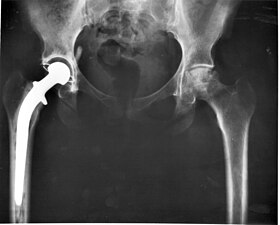Artificial joint
| Joint replacement | |
|---|---|

|
|
| ICD-10-PCS | 0?R?0JZ |
| ICD-9-CM | 81.5, 81.8 |
| MeSH | D019643 |
Replacement arthroplasty (from Greek arthron, joint, limb, articulate, + plassein, to form, mould, forge, feign, make an image of), or joint replacement surgery, is a procedure of orthopedic surgery in which an arthritic or dysfunctional joint surface is replaced with an orthopedic prosthesis. Joint replacement is considered as a treatment when severe joint pain or dysfunction is not alleviated by less-invasive therapies. During the latter half of the 20th century, rheumasurgery developed as a subspecialty focused on these and a few other procedures in patients with rheumatic diseases.
Joint replacement surgery is becoming more common with knees and hips replaced most often. About 773,000 Americans had a hip or knee replaced in 2009.
Stephen S. Hudack, a surgeon based in New York City, began animal testing with artificial joints in 1939. By 1948, he was at the New York Orthopedic Hospital (part of the Columbia Presbyterian Medical Center) and with funding from the Office of Naval Research, was replacing hip joints in humans.
Two previously popular forms of arthroplasty were: (1) interpositional arthroplasty', with interposition of some other tissue like skin, muscle or tendon to keep inflammatory surfaces apart and (2) excisional arthroplasty in which the joint surface and bone were removed leaving scar tissue to fill in the gap. Other forms of arthroplasty include resection(al) arthroplasty, resurfacing arthroplasty, mold arthroplasty, cup arthroplasty, and silicone replacement arthroplasty. Osteotomy to restore or modify joint congruity is also a form of arthroplasty.
In recent decades the most successful and common form of arthroplasty is the surgical replacement of a joint or joint surface with a prosthesis. For example, a hip joint that is affected by osteoarthritis may be replaced entirely (total hip arthroplasty) with a prosthetic hip. This procedure involves replacing both the acetabulum (hip socket) and the head and neck of the femur. The purpose of doing this surgery is to relieve pain, to restore range of motion and to improve walking ability, leading to the improvement of muscle strength.
...
Wikipedia
